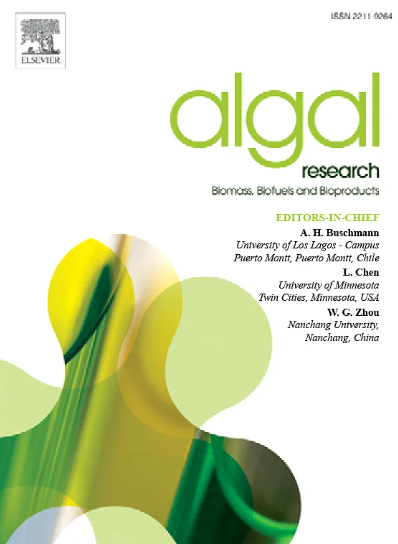Dynamics and secondary pollution risk assessment of heavy metals during Sargassum polycystum floating and decomposing process
IF 4.5
2区 生物学
Q1 BIOTECHNOLOGY & APPLIED MICROBIOLOGY
Algal Research-Biomass Biofuels and Bioproducts
Pub Date : 2025-05-21
DOI:10.1016/j.algal.2025.104104
引用次数: 0
Abstract
Sargassum ranks among the most prolific seaweed species in coastal regions across the globe. Its swift biomass accumulation is predominantly propelled by heightened nutrient concentrations. In coastal waters, a substantial amount of Sargassum has amassed and undergone decomposition, resulting in the release of carbon (C), nitrogen (N), phosphorus (P), and heavy metals into the environment, thereby exerting detrimental effects on coastal habitats. The present study implemented a 72-day laboratory controlled experiment utilizing litter bag technology to simulate the floating stage of S. polycystum. The results showed that the decomposition rate of the low-density S. polycystum group was significantly higher than that of the medium-density, high-density, natural, dried, and frozen S. polycystum groups. The heavy metals contents of S. polycystum were in the following order: Fe > Zn > Mn > As > Cr > Cu > Ni > Pb > Cd > Se. Fe predominantly exhibits a release effect (MAI < 100 %). In contrast, Zn, Mn, and Se primarily demonstrate an accumulation effect (MAI > 100 %), As, Cd, Cr, Cu, Pb, and Ni display both release and accumulation effects concurrently. At least Fe (35.12 %–50.22 %), Cd (30.76 %–49.44 %), Ni (4.63 %–6.37 %), Cu (2.51 %–10.71 %), Cr (75.64 %–92.3 %), As (17.44 %–20.02 %), and Pb (37.09 %) in S. polycystum were released back to the water. The C contents during the decomposition process of S. polycystum were stably maintained, the N and P contents increased during the experiment. The present study revealed the decomposition characteristics of S. polycystum and its environmental impact, providing a theoretical basis for marine ecological environmental protection of seaweed bed.
马尾藻漂浮分解过程中重金属动态及二次污染风险评价
马尾藻是全球沿海地区最多产的海藻物种之一。其快速的生物量积累主要是由提高的养分浓度推动的。在沿海水域,大量马尾藻积聚并分解,导致碳(C)、氮(N)、磷(P)和重金属释放到环境中,从而对沿海栖息地产生不利影响。本研究采用垃圾袋技术进行了72天的室内对照试验,模拟了多囊藻的漂浮阶段。结果表明,低密度多穗草组的分解率显著高于中密度、高密度、天然、干燥和冷冻多穗草组。多囊藻重金属含量的大小顺序为:Fe >;锌比;Mn祝辞比;Cr祝辞铜比;倪祝辞Pb祝辞Cd比;Se。铁主要表现为释放效应(MAI <;100%)。相反,锌、锰和硒主要表现为积累效应(MAI >;100%), As, Cd, Cr, Cu, Pb和Ni同时表现出释放和积累效应。至少Fe (35.12% - -50.22%), Cd(30.76% - -49.44%),镍(4.63% - -6.37%)、铜(2.51% - -10.71%)、铬(75.64% - -92.3%),为(17.44% - -20.02%),Pb(37.09%)在美国polycystum被释放回水中。多囊参分解过程中C含量保持稳定,N、P含量增加。本研究揭示了S. polycystum的分解特性及其对环境的影响,为海藻床的海洋生态环境保护提供了理论依据。
本文章由计算机程序翻译,如有差异,请以英文原文为准。
求助全文
约1分钟内获得全文
求助全文
来源期刊

Algal Research-Biomass Biofuels and Bioproducts
BIOTECHNOLOGY & APPLIED MICROBIOLOGY-
CiteScore
9.40
自引率
7.80%
发文量
332
期刊介绍:
Algal Research is an international phycology journal covering all areas of emerging technologies in algae biology, biomass production, cultivation, harvesting, extraction, bioproducts, biorefinery, engineering, and econometrics. Algae is defined to include cyanobacteria, microalgae, and protists and symbionts of interest in biotechnology. The journal publishes original research and reviews for the following scope: algal biology, including but not exclusive to: phylogeny, biodiversity, molecular traits, metabolic regulation, and genetic engineering, algal cultivation, e.g. phototrophic systems, heterotrophic systems, and mixotrophic systems, algal harvesting and extraction systems, biotechnology to convert algal biomass and components into biofuels and bioproducts, e.g., nutraceuticals, pharmaceuticals, animal feed, plastics, etc. algal products and their economic assessment
 求助内容:
求助内容: 应助结果提醒方式:
应助结果提醒方式:


